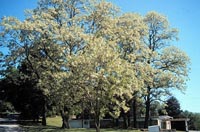Resource Library
Plant of the Week: Locust, Black
The University of Arkansas System Division of Agriculture does not promote, support or recommend plants featured in "Plant of the Week." Please consult your local Extension office for plants suitable for your region.
Plant of the Week
Black Locust
Latin: Robinia pseudoacacia

Fayetteville is enjoying an annual rite of spring: the blooming of the sweetly scented black locust. The pendant clusters of creamy white flowers of these 60-foot tall trees are in great abundance this year, probably encouraged by the dry weather we "enjoyed" last summer.
Every year when the black locust bloom, I am struck by the beauty of the tree and the odd fact that it’s so seldom grown as an ornamental in its own native range. This member of the legume family is native from Pennsylvania to Alabama in the Appalachian chain and on the Ozark Plateau in our part of the world.
The black locust often grows in little groves. It produces root suckers. Foresters consider it a medium-growing species. The trunk grows about a quarter of an inch per year. The trunks is usually tall and straight with most of the closely held limbs near the top of the tree.
The inch-long creamy white, pea-shaped flowers are borne in six-inch long clusters and are highly fragrant. The plant produces pods similar to those found on redbuds. The leaves are compound with 11 to 20 oval leaflets.
Pink-flowered and thornless forms are sold in drier parts of the western United States where the tree is often used as a landscape plant. Several selections with golden foliage such as ‘Aurea’ and ‘Frisia’ have been developed and are common in gardens of the Pacific Northwest. These golden leaf forms may not hold their yellow color all summer in our heat.
The black locust is the third most important hardwood timber species in the world, behind only eucalyptus and hybrid poplar, but it’s seldom grown in the United States because of a borer that infests trees grown for timber. In Europe and Asia, thousands of acres of the trees are planted for both posts and lumber purposes.
The story of the popularization of black locust in Europe is an interesting, if somewhat bizarre, tale. The tree was first introduced into Europe in the early 1600s, but it was not until the late 1700s that it began to be promoted as a plantation tree, especially for use in ship building. The decay resistance of black locust is legendary. It’s said to last 10 years longer than stone. In reality, it’s estimated to last 500 years when exposed to wet conditions and 1,500 years when kept relatively dry.
The principle European apostle of the merits of black locust was William Cobbett (1763-1835), a journalist with a knack for getting crosswise with authority figures. He was forced to flee England and arrived in Philadelphia in 1792. There he became a vocal opponent of the democracy movement in the United States.
He especially attacked Thomas Paine, the author of The Rights of Man and The Age of Reason. But what eventually lead to his leaving the United States was his public attack of Dr. Benjamin Rush for medical malpractice during the good doctor’s treatment of the dying George Washington.
But his stay in America changed him. When he returned to England, he began to rail against the Crown. This lead to his involvement with the British worker movement, which again resulted in his expulsion back to America in 1816. On his Long Island property, he started a tree farm and became convinced of the merits of black locust.
After two years, things had cooled down and he decided to return to England, but not alone. After undergoing a metamorphoses of belief, he now considered Thomas Paine a hero, so he had his body dug up and took it back to England with him with the intent of building a monument for the American author. Salt in the wound of authority, so to speak.
To support his English farm, Cobbett began promoting and selling black locust seeds and trees. His 1825 book, The Woodlands, was the real catalyst for popularizing the tree throughout much of Europe. During the years that followed, a black locust craze swept Europe, not unlike the emu farming craze of recent years.
Oh, by the way, Thomas Paine never got his monument. On Cobbett’s death, the coffin in which his remains were kept was sold to a London secondhand furniture dealer and the bones were discarded so the coffin could be resold.
The black locust is one tough tree. It grows on almost any soil, making it a popular choice for planting on mine-spoil sites. It’s been reported as growing on soils with a pH as low as 2.5!
Because it fixes its own nitrogen by means of nodules on the roots, the black locus fertilizes itself. It’s exceedingly drought tolerant and is a popular street tree in the low rainfall areas of western states.
By: Gerald Klingaman, retired
Extension Horticulturist - Ornamentals
Extension News - May 4, 2001
The University of Arkansas System Division of Agriculture does not maintain lists of retail outlets where these plants can be purchased. Please check your local nursery or other retail outlets to ask about the availability of these plants for your growing area.